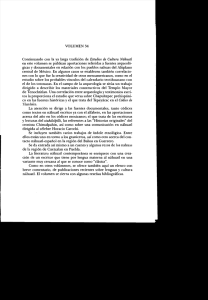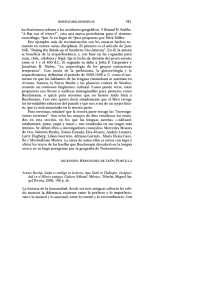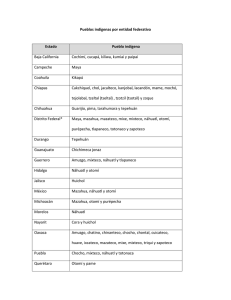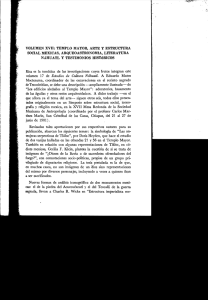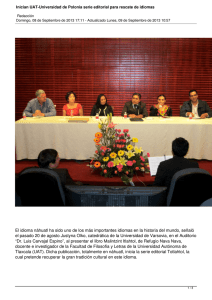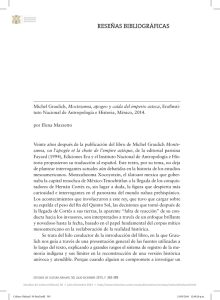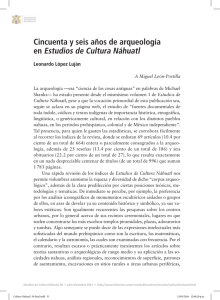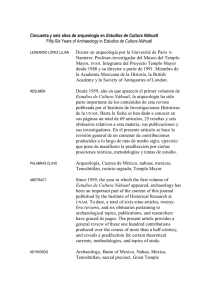THE UNIVERSITY OF WESTERN ONTARIO
Anuncio
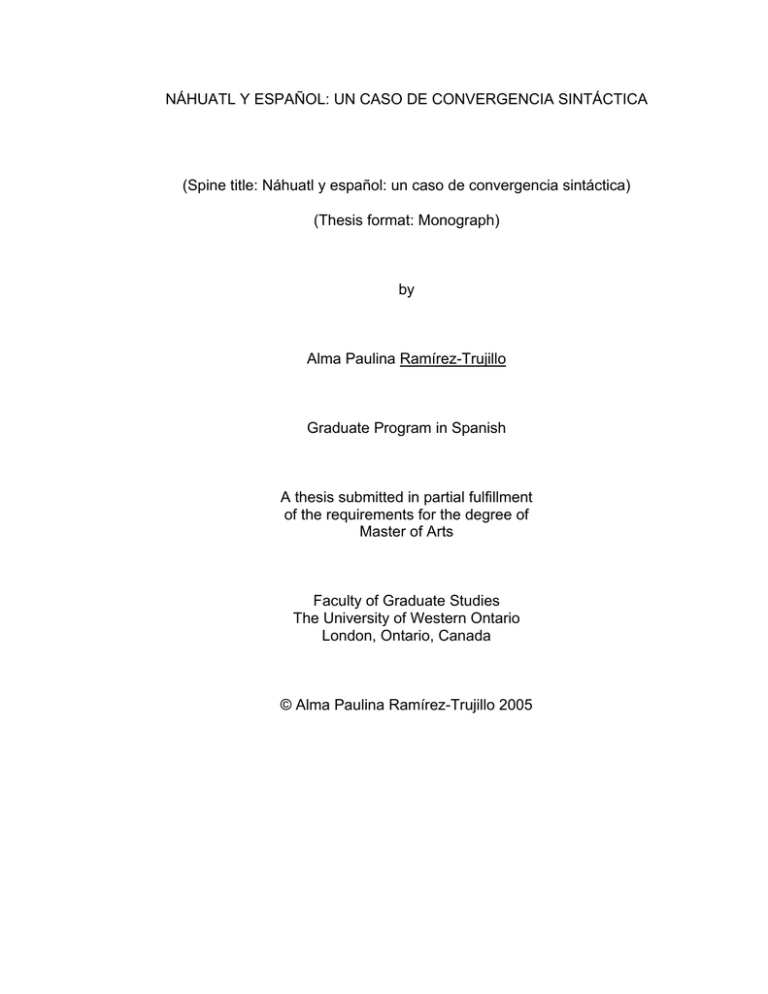
NÁHUATL Y ESPAÑOL: UN CASO DE CONVERGENCIA SINTÁCTICA (Spine title: Náhuatl y español: un caso de convergencia sintáctica) (Thesis format: Monograph) by Alma Paulina Ramírez-Trujillo Graduate Program in Spanish A thesis submitted in partial fulfillment of the requirements for the degree of Master of Arts Faculty of Graduate Studies The University of Western Ontario London, Ontario, Canada © Alma Paulina Ramírez-Trujillo 2005 THE UNIVERSITY OF WESTERN ONTARIO FACULTY OF GRADUATE STUDIES CERTIFICATE OF EXAMINATION Supervisor Examiners ______________________________ Dr. Joyce Bruhn de Garavito ______________________________ Dr. Elena Valenzuela ______________________________ Dr. David Heap ______________________________ Dr. Chet Creider The thesis by Alma Paulina Ramírez-Trujillo entitled: NÁHUATL Y ESPAÑOL: UN CASO DE CONVERGENCIA SINTÁCTICA is accepted in partial fulfillment of the requirements for the degree of Master of Arts Date__________________________ _______________________________ Chair of the Thesis Examination Board ii ABSTRACT Recent research suggests that, when the two languages spoken by bilinguals share certain features, but one of the languages favors the use of a particular structure, possibly due to pragmatic reasons, the two languages may converge in the relevant domain (Hulk and Müller 2000; Müller and Hulk 2001; Sánchez 2003; Sánchez, 2004; Toribio 2001). This in turn may lead to convergence between the two languages in a society where most of the speakers are bilingual, assuming bilinguals and second language learners are often the agents of language change (Winford, 2003). Classical Nahuatl is a polysynthetic language (Baker, 2001) with variable word order (Bruhn de Garavito et al., 2005). We find both postpositions (1a) and prepositions (García Escamilla, 1993), although it seems the use of postpositions was more frequent (Kartunnen y Lockhart, 1976; Siméon, 1885; Sullivan, 1992; Lockhart, 1992, Tuggy, 1991). Spanish, on the other hand, is a head initial language with prepositions (1c). After 500 years of contact, modern Nahuatl speakers are almost all bilingual. According to the recent suggestions summarized above, this would predict a preference in modern speakers for prepositions in Nahuatl. Although in recent years several modern grammars of Nahuatl have been produced (Tuggy; 1991; Sullivan, 1992), all continue to emphasize the existence of postpositions, possibly because it is convenient to focus on the classical language and thus to avoid the problems of dialect variation. It seems necessary therefore, to establish the status of adpositions in current Nahuatl in order to determine up to what point convergence with Spanish is taking place. Classic Nahuatl (a) 1) xochi- ti- ca flower- link- prep-on ‘on the flower’ Modern Nahuatl (b) icaxochitl prep-on flower ‘on the flower’ Spanish (c) en la flor prep-on the flower ‘on the flower’ 2) mesa pan table prep-on ‘on the table’ ipan mesa prep-on table ‘on the table’ en la mesa prep-on the table ‘on the table’ This study was carried out in the town of San Andrés Azumiatla, in the state of Puebla. Most of the informants were illiterate, so it was appropriate to try different methodologies. The first one was to illicit the relevant structures from informants using translation and grammaticality judgments. The second one involved the use of a short story in Spanish. This story was told to the participants with the help of pictures. After hearing the story, they were asked questions about it. Those questions were posed in Nahuatl and did not involve the prepositions they were meant to elicit. Participants produced sentences using exclusively prepositions in Nahuatl. The judgments of the informants were also that postpositions were not possible. These results support the predictions regarding convergence under these conditions. iii KEYWORDS Convergencia sintáctica, español, náhuatl, transferencia, interferencia, lenguas en contacto, lenguas indígenas, México, Puebla, muerte de la lengua, préstamos gramaticales, preposiciones, posposiciones, adpsosiciones. iv GLOSARIO Borrowing: Prestabilidad. Este término puede ser traducido también como ‘préstamos’, sin embargo, con prestabilidad nos referimos al proceso de tomar prestado y no a lo que se toma en préstamo. La aplicación de este término está en la página 8. Borrowing language: Lengua receptora (ver página 8). Causal mechanisms: Mecanismos causales (ver página 30). Cross-linguistic interference: Interferencia inter-lingüística (ver página 43). Elite closure: Cierre de la elite (ver página 11). Entrenchment: Cimentación (ver página 31). Hierarchy of borrowability: jerarquía de prestabilidad (ver página 48). Indigenized language: Lengua indigenizada (ver página 11). Language shift: Desplazamiento de la lengua (ver página 9). Policy makers: Creadores de políticas (ver página 11). Processual mechanisms: Mecanismos procesales (ver página 30). Proximal causes: Causas próximas (ver página 30). Source language: Lengua fuente (ver página 8). Target language: Lengua meta. Este término, también se refiere a la ‘lengua fuente’, ya que en el caso del náhuatl, la segunda lengua (español) es la lengua que proveé lo que el náhuatl toma en préstamo. En algunas citas, la lengua meta estará referida con las iniciales TG en lugar de LM (ver página 9). Ultimate causes: Causas finales (ver página 30). v Agradecimientos Primero que nada quiero agradecer a todas las personas que participaron para que esta tesis fuera posible. Empezando por Joyce Bruhn de Garavito, mil gracias por su paciencia y por toda su ayuda en estos dos años que no han sido nada fáciles. Gracias también a los profesores; Elena Valenzuela, David Heap y Chet Creider por sus consejos y correcciones. Quiero agradecer también a los participantes de San Andrés Azumiatla y de Cuetzalan por su colaboración en ésta investigación. My thanks to Cécile, Dawn y Teresa McLauchlan for all their support and also because they all helped me to understand them when I did not know how to speak English! Thanks also to Teresa Aconito. Gracias a mi familia por estar conmigo en los momentos más difíciles, por soportarme cuando me estaba volviendo loca, por tener fe en mí y por darme la confianza para seguir adelante. Gracias a mis amigos mexicanos por estar al pendiente de mis aventuras en Canadá and also thanks to my new Canadian friends and my friends from other parts of the world. Thanks for making these two years the best ones of my life (so far). Gracias a Dios por dejarme vivir otra vez la adrenalina de la defensa de una tesis, gracias por ponerme en el lugar indicado y por dejarme continuar con esta aventura. ¡Y vamos por la tercera! The research carried out for this project was made possible by a grant from the Social Sciences and Humanities Council of Canada to Joyce Bruhn de Garavito, for which I am truly grateful. Todos los errores que se lleguen a encontrar en esta tesis son míos. vi A mis padres y a mis hermanos, por su valentía y por no tener miedo a los cambios. Por enseñarme a no rendirme incluso cuando parece no haber solución a los problemas. TABLA DE CONTENIDO Certificado de examen........……………………………………………………………….ii Abstract…..…………………………………………………………………………...…..iii Keywords…………………………………………………………………………………iv Glosario……………………………………………………………………………………v Agradecimientos…..……………………………………………………………………...vi Dedicatoria……………………………………………………………………………….vii Tabla de contenido………………………………………………………………………viii Lista de tablas……………………………………………………………………………xi Lista de figuras…………………………………………………………………………..xii Lista de apéndices……………………………………………………………………….xiii Introducción.........................................................................................................................1 CAPITULO I EL ESPAÑOL Y EL NAHUATL: UNA MUESTRA DE INTERSUPERVIVENCIA...............................................................................................5 1. Lenguas en contacto.........................................................................................................5 1.1 El náhuatl en contacto con el español..........................................................................12 1.2 Las lenguas indígenas en el México actual..................................................................19 1.3 Las lenguas indígenas en el estado de Puebla..............................................................21 1.4 El náhuatl en San Andrés Azumiatla y algunas experiencias durante la investigación de campo................................................................25 viii CAPITULO II CONVERGENCIA SINTÁCTICA: UNA INTRODUCCIÓN A LA LENGUA NÁHUATL.......................................................................................................................28 2. Situaciones de contacto que inducen el cambio en las lenguas.....................................28 2.1 Transferencia e interferencia: algunos conceptos problemáticos................................31 2.2 Convergencia y Sprachbünd........................................................................................33 2.2.1 Préstamos gramaticales: convergencia estructural........................................36 2.2.2 ¿Cuál es la dirección que sigue la convergencia?.........................................38 2.2.3 Factores que conducen a la convergencia.....................................................39 2.3 Hipótesis de Interferencia Funcional e Hipótesis de Convergencia Funcional....................................................................................................41 2.3.1 Bilingüismo en las lenguas en contacto: el estudio de Hulk y Müller (2000)........................................................................43 2.4 Los cambios en el náhuatl............................................................................................46 2.4.1 Primera etapa (1519-1550)...........................................................................46 2.4.2 Segunda etapa (1550-1650)..........................................................................48 2.4.3 Tercera etapa (1650-1800): el cambio de las posposiciones nahuas............49 2.4.4 Cuarta etapa (1800-¿?)..................................................................................49 2.5 Nuestra postura............................................................................................................51 2.6 Una breve descripción del náhuatl...............................................................................54 ix 2.6.1 Reverenciales u honoríficos......................................................................................55 2.6.2 Neologismos.............................................................................................................56 CAPITULO III. LAS ADPOSICIONES EN NÁHUATL Y EN ESPAÑOL: EL EXPERIMENTO Y SUS RESULTADOS………………………………………...57 3.1 El español y el náhuatl, dos lenguas diferentes............................................................57 3.2 El orden del sintagma preposicional en español y en náhuatl.....................................63 3.3 Las posposiciones en náhuatl.......................................................................................66 3.4 Aclaraciones antes del experimento.............................................................................68 3.4.1 El experimento: las metodologías y los participantes...................................71 3.4.2 El significado de las posposiciones incluidas en nuestro estudio.................73 3.5 Resultados....................................................................................................................76 3.5.1 Primer test.....................................................................................................76 3.5.2 Segundo test..................................................................................................79 3.6 Los prefijos posesivos y las adposiciones...................................................................81 3.7 La discusión: ¿preposiciones o posposiciones en náhuatl?.........................................83 3.8 Relación de nuestro resultados con el análisis teórico presentado en los Capítulos I y II?............................................................89 3.9 Conclusiones: el futuro del náhuatl en contacto con el español..................................94 Comentarios finales...........................................................................................................98 Referencias bibliográficas..................................................................................................99 Apéndices.........................................................................................................................103 Vita...........................................................................................…………………………127 x LISTA DE TABLAS Tabla 1. Población de 5 y más años y total de hablantes de lengua indígena....................23 Tabla 2. Población hablante de lengua indígena por tipo de lengua según sexo y tasa de crecimiento promedio anual en el periodo 1990-2000.....................24 Tabla 3. Ejemplo 1 del uso de los honoríficos en náhuatl.................................................55 Tabla 4. Ejemplo 2 del uso de los honoríficos en náhuatl.................................................56 Tabla 5. Ejemplo 3 del uso de los honoríficos en náhuatl.................................................56 Tabla 6. Ablativo Seudo-preposicional..............................................................................84 xi LISTA DE FIGURAS Figura 1. Clasificación de los tipos de contacto................................................................12 Figura 2. Dimensiones del cambio.....................................................................................29 Figura 3. La cronología del contacto del español con el náhuatl.......................................51 xii LISTA DE APÉNDICES Apéndice 1: Mapas..........................................................................................................103 Apéndice 2: Cuento. Juanita y Pablito en búsqueda del tesoro.......................................104 Apéndice 3: Frases del primer test...................................................................................107 Apéndice 4: Segundo test.................................................................................................112 Apéndice 5: Dibujos acerca del cuento............................................................................120 Apéndice 6: Aprobación ética…………………………………………………………..126 xiii
